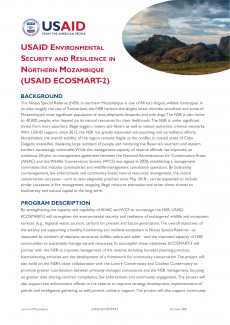BACKGROUND
The Niassa Special Reserve (NSR) in northern Mozambique is one of Africa’s largest, wildest landscapes. In an area roughly the size of Switzerland, the NSR harbors the largest intact miombo woodland and some of Mozambique’s most significant population of lions, elephants, leopards, and wild dogs. The NSR is also home to 40,000 people, who depend on its natural resources for their livelihoods. The NSR is under significant threat from ivory poachers, illegal loggers, miners and fishers as well as violent extremist criminal networks. With USAID support, since 2015, the NSR has greatly expanded anti-poaching and surveillance efforts. Nonetheless, the overall stability of the region remains fragile as the conflict in coastal areas of Cabo Delgado intensifies, displacing large numbers of people and rendering the Reserve’s southern and eastern borders increasingly vulnerable. While the management capacity of reserve officials has improved, an ambitious 20-year co-management agreement between the National Administration for Conservation Areas (ANAC) and the Wildlife Conservation Society (WCS) was signed in 2020, establishing a management committee that includes communities and wildlife-management concession operators. By bolstering co-management, law enforcement, and community-based natural resources management, the recent conservation successes - such as zero elephants poached since May 2018 - can be expanded to include similar successes in fire management, stopping illegal resource extraction and other direct threats to biodiversity and natural capital in the long term.
PROGRAM DESCRIPTION
By strengthening the capacity and capability of ANAC and WCS to co-manage the NSR, USAID ECOSMART-2 will strengthen the environmental security and resilience of endangered wildlife and ecosystem services (e.g., regional water, tourism, carbon) for present and future generations. The overall objectives of the activity are supporting a healthy, functioning and resilient ecosystem in Niassa Special Reserve—as measured by numbers of elephant, carnivores, buffalo, zebra, and sable—and the improved capacity of NSR communities to sustainably manage natural resources. To accomplish these objectives, ECOSMART-2 will partner with the NSR to improve management of the reserve including business planning practices, biomonitoring activities and the development of a framework for community conservation. The project will also build on the NSR’s close collaboration with the Luwire Conservancy and Chuilexi Conservancy to promote greater coordination between privately-managed concessions and the NSR management, focusing on greater data sharing, contract compliance, law enforcement and community engagement. The project will also support law enforcement officials in the reserve to improve strategy development, implementation of patrols and intelligence gathering, as well provide judiciary support. The project will also support community conservation by developing community-based natural resource management (CBNRM) committees, implementing human-wildlife conflict mitigation, and promoting resilient livelihood activities.
EXPECTED RESULTS AND IMPACTS
- Improved Niassa Special Reserve coordination & shared governance (among ANAC & WCS)
- Communities empowered to support concessions
- Operators/concessionaires adhere to best management practices
- Law enforcement better able to effectively deploy and adapt to new circumstances.
- Increased law enforcement presence and coverage
- Community members take greater ownership of conservation activities by forming village-based natural resource committees
- Community members understand the benefits of nature conservation on their livelihoods
- Reduced direct threats to biodiversity, especially poaching

